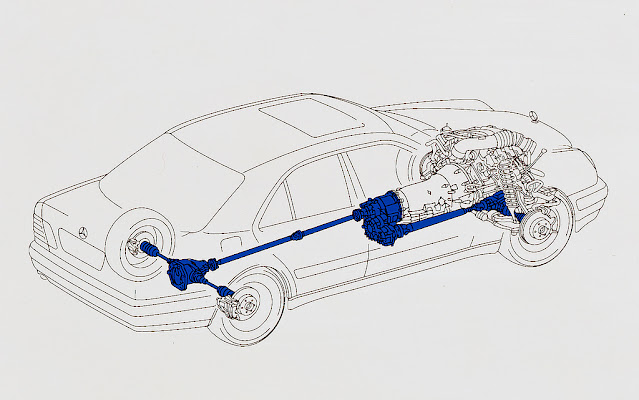This significantly further developed generation of all-wheel drive made its debut 25 years ago in the E 280 4MATIC and E 320 4MATIC models of the E-Class 210 model series. Both were equipped with V6 engines of the newly developed M 112 model series with three-valve technology and dual ignition. These vehicles were presented to an international general public for the first time at the AutoRAI trade fair in Amsterdam from 6 to 16 February 1997. The E 280 4MATIC was available immediately after this premiere, the market launch of the higher-displacement variant followed in June 1997.
The new 4MATIC was not the first all-wheel drive from Mercedes-Benz. But it sets standards 25 years ago for the comfortable handling of passenger cars even under difficult winter conditions, such as icy and snowy roads. The trade journal “auto motor und sport” writes in its July 1997 issue about “almost foolproof driving stability, coupled with unrivalled traction on slippery surfaces”. Compared to the first 4MATIC, presented in 1985 in the upper mid-range 124 model series, which “only intervened when things got noticeably slippery”, the report positively highlights the permanent all-wheel drive strategy. Not only is this intended for critical road conditions, but also fundamentally improves driving behaviour in dynamic situations. The sales brochure for the 210 model series saloons says of the new 4MATIC: “The permanent all-wheel drive ensures [...] excellent traction and driving stability when accelerating and especially when cornering.” This resulted in “easy handling, active driving safety, dynamics at the highest level and lots of driving pleasure”.
All-wheel drive tradition from Mercedes-BenzThe history of Mercedes-Benz vehicles with all-wheel drive goes back to the early years of the 20th century. The “Illustrirte Zeitung” wrote in retrospect in 1917 about Paul Daimler, then technical director of the Österreichische Daimler-Motoren-Gesellschaft in Wiener Neustadt, who “in 1903 [...] laid the foundations for four-wheel drive design”. After the first vehicles for the Austrian and Prussian military in the years 1905 to 1907, Daimler-Motoren-Gesellschaft built the “Dernburg-Wagen” in 1907, the first passenger car ever with all-wheel drive and all-wheel steering, which was delivered to German South West Africa in 1908. Benz & Cie. also produced various all-wheel drive prototypes during this period. The first market-ready Benz car with four-wheel drive was the VRL off-road vehicle, which was, of course, only built as a one-off around 1920.
After the merger to form what was then Daimler-Benz AG in 1926, all-wheel drive vehicles of the Mercedes-Benz brand were created which were also suitable for military use. In the W 136 model series, these include the 170 VG (with all-wheel drive) and 170 VL (with all-wheel drive and four-wheel steering) models. The Mercedes-Benz G5 (W 152) with all-wheel drive and selectable four-wheel steering, which was unveiled in 1938, proved itself as an emergency vehicle for the Berchtesgaden mountain rescue service, among others, which continued to use this model until the 1950s.
Even the first generation of the 4MATIC is a milestone in Mercedes-Benz chassis development. It is presented at the International Motor Show (IAA) in Frankfurt am Main in September 1985. The automatically engaging four-wheel drive has its premiere in the saloons and estates with six-cylinder engines of the 124 model series, the 260 E 4MATIC and 300 E 4MATIC models. These all-wheel-drive variants of the later first E-Class are delivered from 1987. By this time, the model range has been extended to include the 300 D 4MATIC and 300 D Turbo 4MATIC. The 4MATIC is the most technically complex system of the “Mercedes-Benz Driving Dynamics Concept” introduced in 1985, which also includes the Automatic Locking Differential (ASD) and the Traction Control System (TCS).







No comments:
Post a Comment